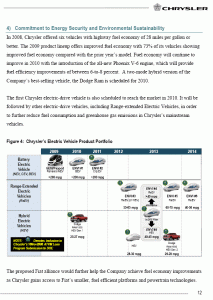The Honey Trap for Obama
I argued last week that all the electric vehicle talk we heard so much of at Chrysler and GM during their restructuring (remember all those GM electric car ads on TV, which have now disappeared?) were just a honey trap for Obama. Auto makers knew that they were not designing a car for the masses, but for one man, to get him to put taxpayer money into their companies. Now that they actually have to think about selling these cars to the public, the ads have disappeared and now Chrysler is ending its EV program.
I want to take you back to their restructuring plan. The plan had 7 steps, listed in priority order. The first and second priority was restructuring. The third priority was a deal with Fiat. The next priority, ahead of any others beyond the initial restructuring and Fiat deal, was their EV car program. Here is the page from their plan (click to enlarge)
In fact, this was very clearly a business plan aimed at Obama. Look at the #4-7 priorities and their order. Only one potential investor in the whole world would appreciate these priorities. Any private investor would find these priorities nuts:
4) Commitment to Energy Security and Environmental Sustainability
5) Compliance with Fuel Economy Regulations
6) Compliance with Emissions Regulations
7) Achieving a Competitive Product Mix and Cost Structure
So "achieving a competitive product mix and cost structure," arguably the problem that drove them into bankruptcy, is their dead last priority! Welcome to government motors, where commitment to energy security is more important than having a competitive product mix or cost structure.

What makes me laugh about your post is the thought that all the government/lefty types that read the business plan are thinking "yeah, what's wrong with that?"
Chrysler is not ending its EV program; it has disbanded its stand-alone EV/hybrid vehicle team and integrated the development into their regular product development effort.
http://rumors.automobilemag.com/6589184/green/chrysler-electric-car-development-team-envi-disbanded/index.html
"However, Chrysler’s engineers will still take the lead in developing new electric and hybrid vehicles for the Fiat organization, and former ENVI chief Lou Rhodes is now in charge of EV development for the entire company.
According to Reuters, Fiat is interested in developing an electrified commercial van for the U.S. market -- a suitable replacement for the Town & Country EV cargo van once promised"
As I mentioned before -- this makes a lot more sense. General acceptance of EV and hybrid, long term, is going to be based on normal vehicle platforms; not 'statement' vehicles like the EV1 and Insight, which trade off practicality for making a "Look At How Much Better I Am Than You!" statement. You do that by making an EV/hybrid platform that you build normal cars off of, or you develop normal cars that can accept a range of powertrains, including series or parallel hybrids and BEVs.
The whole electric car deal is a farce. I looked up the specs for the Chevy Volt and ran a few calculations:
1) It has 16 KWH battery. This is >20 HP hours. If you
use 40 HP, the battery will be dead in 30 minutes.
2) It has a 1.0 liter engine for backup. This has a
rating of 40KW continuous, which is ~53 HP.
They report a range of 40 miles on electricity alone. If you do this in one hour, the car is using 20 HP. What kind of car and/or performance can you have with a 20 HP power source?
Another problem: Idle night-time electricity available is about 15 KWH per household. Thus, the 16 KW battery can be recharged overnight with existing generating capacity. If more recharging is required (a bigger battery), dedicated generating capacity must be built, to be used only at night for electric cars. This will increase costs enormously.
The only feasible electric car appears to be a small, golf cart size vehicle for short, low speed trips. California mandated electric cars a dozen years ago. Billions were spent on development, and the whole thing was a fiasco.
Since any engineer can run the calcs in a few minutes, it is apparent that these schemes are hatched for political purposes, with no expectation of success, other than getting government grants.
If anyone has an idea (complete with numbers!) on how to make full electric cars feasible, taking the whole system into account, I would love to hear it.